Fred Martin
A Retrospective, 1948-2003
Catalog illustrations with commentaries...
Catalog nos.
1-26 Click for
Catalog
nos. 30-54
Catalog
nos. 55-63
Catalog
nos. 65-77
Catalog
nos. 78-115
Catalog
nos. 119-137
 |
Cat. no. 1.
Sunrise. Spring 1948.
Oil on Masonite, 20 x 24 in.
I thought once there was a necklace in eternity, and our lives the
search for its stones fallen and scattered through time. This
painting is a rectangle showing a sunflower above and a starflower
below. It shows somehow also man on the left and woman on the right
and in the center a binding of them together. A mandala is a circle
usually divided into four complementary/oppositional parts. As if
this painting were a mandala, there are here the union of earth and
sky—and night and day—and male and female that is the whole of myself
living in the world. The painting is the oldest of my works to have
survived—perhaps the first of the stones I may have found from the
necklace in eternity.
|
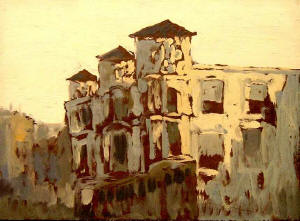 |
Cat. no. 12. Golden Gate
at Laguna. 1957-58.
Oil on Masonite, 10 x 14 in.
Collection Oakland Museum of California.
For a few autumn months in 1949, I rode the streetcar to work each
evening (my shift was 6pm-2am). One evening I looked at the orange
transfer in my hand, remembered a picture of a Tang Dynasty Apple
Blossom Vase I had seen, thought of the art I hoped to make and
wrote in the back of the book I was reading—“That this light which
once so fell should ever so fall, even unto the final dust.” Ten
years later, I painted the decrepit shells of rotting timbers and
peeling plaster that were the old houses and apartments in the Western
addition of San Francisco. I painted on the spot the way I thought
Corot had made Roman sketches to use in the studio back in Paris, but
I was making Western Addition paintings of the ruin in myself.
Corot’s paintings were souvenirs—to “come again”—of Rome; mine were
the dying light of the rotting city of my soul.
|
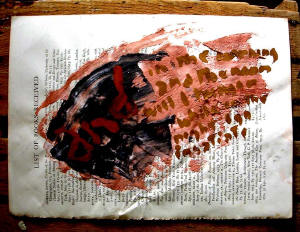 |
Cat. no. 13c. “And in the
morning…” 1957-8. Texture paint on paper, 8¼ x 12 in.
A place gets into me and I paint it, but after a while there are too
many associations—words, textures, objects, sounds, presences—for a
picture to satisfy them. While I was painting pictures of the rotting
mansions of the Western Addition, we were living in Oakland in a house
as decrepit as any in San Francisco. I tried to hide the cracks in
our house with a paste called “texture.” And soon enough, “texture”
became a paint transmuted into the dirt and dust of the gutters and
abandoned street corners of the Western Addition—“the aurum nostrum
of our dying day” smeared here on art history (The Art Bulletin)
with the knowledge that “in the morning and the noon will I hunger
while in the night I go insatiate.”
|
|
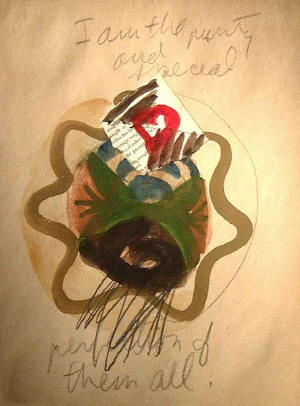 |
Cat. no. 14a. From the series
“Do you know my name?” 1958.
Watercolor, gouache, pencil, and collage on paper, 12 x 9 in.
After a time I gave up pictures of places and the textures of dusts
that were the dark mirrors of me. To transform, that would be what I
would try to do. I had been reading Jung for years, and even before
Sunrise (cat. no. 1 above), I had wandered in art into what he called
“active imagination.” I asked, “Do you know my name?” and set out in
a quickly evolving series of painting-collages to find out what my
name might be. Jung would have called it Self, someone else might
call it soul, but I think it’s what the Greeks called Daimon.
I did not find my name, but I did receive “I am the purity and special
perfection of them all” (cat. no. 14c) It was not my name but an
image of art to live by.
|
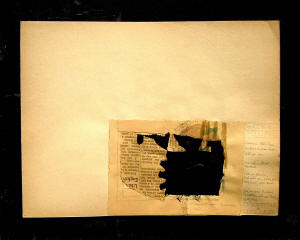 |
Cat. no. 18. Goodbye,
Betty Mae. 1959. Watercolor, gouache, pencil, and collage on
paper, 9 x 12 in.
Every night after work and family, I went to the studio to make
collages. Lots of collages, 9 x 12 inch sheet after sheet to show and
develop the images churning in my head. Whatever concerned me, I made
a collage—and then, because the churning was still there, I made
another collage, and another, and another. Between 1958 and the early
1960s, I made around three thousand of them. One of the churnings was
about loss, my fear as an individual to be lost in the entropic dust
of the forgotten dead. Betty Mae was one of those lost. One night I
made this collage in her memory “…on down to nothing with you now.” I
guess that in order to save me, I gave to her what I feared for me.
However, she was not, nor will I be spared “…on down to nothing with
you now.”
|
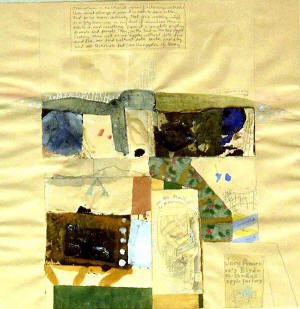 |
Cat. no. 21. Joey America.
1964.
Watercolor, gouache, pencil, and collage on paper, 18 x 18 in.
Collection Oakland Museum of California
As the years 1961 through 1965 passed, the little collages grew into
bigger ones. Thoughts that grew over many collages now grew all
through one collage. And the churning concerns were, yes, still sex
and death, but now in the form of family and the course of the
generations. I was “Joey America” (it was Pop Art time and names like
that were in the air); my wife was “Venus Genetrix” (I had been
reading about Rome and Virgil and his Georgics); and in my art
I set out to build the Western Homestead of past and now and forever.
I was no longer a wanderer in the dying streets of a Western Addition;
I had become the Good Husbandman of a homestead in Rainbow Land.
Stones from a necklace? In these years I found and shaped the great
shining medallion of the center, finally making it into the book
Beulah
Land
(see cat. no. 118, below).
|
 |
Cat. no. 26. From
the Carpenter Series, Untitled. 1966-67.
Gouache with pastel on paper, 24 x 36 in. Collection Oakland
Museum of California.
In
1965-66, I did nothing but draw and etch that place I called Beulah
Land. I wore out the imagery and my hands were cramped and my arms
stiff as sticks. What to do next? On the long Labor Day weekend of
1966, I went to the studio and with the words from a then popular
song—“If I were a carpenter, would you follow me anywhere, would you
have my baby?”—set out to paint like a rough carpenter using his arms
to hammer together the studs and rafters of a house… and to have
whatever baby my art might give. I made hundreds of these paintings.
The cannons of the phallus, the pyramids of Egypt as the granaries of
Joseph (an old myth I had read), and the far mountains whence spring
the four rivers of paradise (from a sixth century mosaic at Sts.
Cosmas and Damiano in Rome). Those mountains and rivers have stayed
with me forever.
|
Click for
Catalog
nos. 30-54
Catalog
nos. 55-63
Catalog
nos. 65-77
Catalog
nos. 78-115
Catalog
nos. 119-137
|